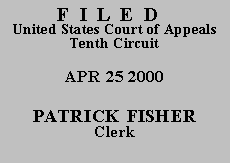 UNITED STATES COURT OF APPEALS
UNITED STATES COURT OF APPEALS
 UNITED STATES COURT OF APPEALS
UNITED STATES COURT OF APPEALS
TENTH CIRCUIT
| UNITED STATES OF AMERICA, | |
| v. | No. 99-6230 |
| EWING HIRATA VISE, | (D.C. No. CR-98-81-M) |
ORDER AND JUDGMENT(*)
Before BALDOCK, HENRY, and LUCERO, Circuit Judges.(**)
Defendant Ewing Hirata Vise pled guilty to manufacturing methamphetamine in violation of 21 U.S.C. § 841(a) and being a felon in possession of a firearm in violation of 18 U.S.C. § 922(g)(1). Shortly after his plea, the Government filed an information pursuant to 21 U.S.C. § 851, notifying Defendant that the Government intended to seek an increased sentence under the mandatory sentencing scheme contained in 21 U.S.C. § 841(b)(1)(A). Because Defendant had two prior drug convictions and the information alleged a quantity of methamphetamine in excess of the statutory requirement, Defendant was subject to a life sentence.(1)
In Defendant's presentence report (PSR), the probation office calculated Defendant's guideline range as 188-235 months. In calculating his base offense level, the PSR attributed 2860 grams of methamphetamine to Defendant. Of this amount, only 2.87 grams were attributable to the § 841(a) charge. The remainder arose from evidence of collateral drug-related conduct. For purposes of sentencing, the district court adopted the PSR's drug quantity calculation. Because the district court found the amount of methamphetamine exceeded the amount required for mandatory sentencing under § 841(b)(1)(A), the court sentenced Defendant to life imprisonment on the drug charge,(2) and a concurrent ten year sentence on the felon in possession charge. See 18 U.S.C. § 924(a)(2). Defendant appeals, challenging only his life sentence. Our jurisdiction arises under 18 U.S.C. § 3742(a)(1).
After Defendant's sentencing but during the pendency of this appeal, we decided United States v. Santos, 195 F.3d 549 (10th Cir. 1999). In Santos, we held that § 841(b)'s mandatory sentencing provisions apply only when the drug amount involved in the offense of conviction meets the statutory requirement. Santos, 195 F.3d at 551-552. Drug quantities which would qualify as "relevant conduct" for sentencing calculations under the sentencing guidelines, see U.S.S.G. § 1B1.3, are irrelevant to the § 841(b) calculation. Santos, 195 F.3d at 551-52. Because we must apply the law in existence at the time we resolve an appeal, United States v. Novey, 922 F.2d 624, 629 (10th Cir. 1991), Santos applies to this case. As the Government acknowledges, the district court erred, albeit through no fault of its own, in relying on the PSR's drug quantity calculation to sentence Defendant to life imprisonment under § 841(b).
Accordingly, we REMAND this cause to the district court with instructions to VACATE Defendant's sentence and RESENTENCE Defendant anew in accordance with Santos.
SO ORDERED.
Entered for the Court,
Bobby R. Baldock
Circuit Judge
*. This order and judgment is not binding precedent, except under the doctrines of law of the case, res judicata, and collateral estoppel. The court generally disfavors the citation of orders and judgments; nevertheless, an order and judgment may be cited under the terms and conditions of 10th Cir. R. 36.3.
**. After examining the briefs and appellate record, this panel has determined unanimously to honor the parties' request for a decision on the briefs without oral argument. See Fed. R. App. P. 34(f); 10th Cir. R. 34.1(A)(2). The case is therefore ordered submitted without oral argument.
1. At the time of Defendant's sentencing, 21 U.S.C. § 841(b)(1)(A)(viii) required that the offense involve "100 grams or more of methamphetamine, its salts, isomers, and salts of its isomers or 1 kilogram of more of a mixture or substance containing a detectable amount of methamphetamine, its salts, isomers, or salts of isomers." In 1998, after Defendant's sentencing, Congress amended § 841(b)(1)(A)(viii), changing the requisite methamphetamine amounts to 50 and 500 grams respectively.
2. Section 841(b)(1)(A)'s mandatory sentencing scheme "trumps" the PSR's guideline calculations. United States v. Campbell, 995 F.2d 173, 175 (10th Cir. 1993).